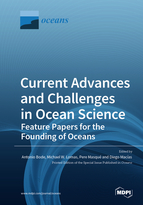Current Advances and Challenges in Ocean Science—Feature Papers for the Founding of Oceans
A special issue of Oceans (ISSN 2673-1924).
Deadline for manuscript submissions: closed (31 July 2021) | Viewed by 65796
Feature Papers for the Founding of Oceans
Special Issue Editors
Interests: marine plankton ecology; nitrogen cycle; food webs; stable isotopes
Special Issues, Collections and Topics in MDPI journals
Interests: phytoplankton; marine biogeochemistry; elemental stoichiometry; primary production; nitrogen cycling; sub/arctic systems; sub/tropical systems
Special Issues, Collections and Topics in MDPI journals
2. Centre for Marine Ecosystems Research, School of Science, Edith Cowan University, Joondalup, WA 6027, Australia
Interests: His research focuses on the study of a variety of key, global environmental processes in both the present day and geologic past, using a suite of stable and radioactive tracers as proxies. These include the Ocean’s role in global climate change as a source or sink of atmospheric CO2; the impact of submarine groundwater discharge (SGD) on nutrient and trace metal biogeochemistry in the ocean; and the reconstruction of the historical patterns of climate, pollution and other natural and anthropogenically-driven processes.
Special Issues, Collections and Topics in MDPI journals
Interests: physical-biological coupling; numerical modelling; climate change impacts; anthropocentric forcing; science-policy interface
Special Issues, Collections and Topics in MDPI journals
Special Issue Information
Dear Colleagues,
This Special Issue is designed to celebrate the founding of the open-access journal Oceans and is focused on presenting new ideas and advances at the cutting edge of Ocean Science. The scope of this Special Issue includes, but is not limited to: ocean geosciences, physics, biogeochemistry, and ecology; ocean ecosystem services and sustainable ocean resource use; and ocean operations and engineering. We encourage researchers from all areas of Ocean Science to submit abstracts for this Special Issue. We will then make a decision on full manuscript for this Special Issue or as a regular paper.
Oceans is an open-access journal that normally charges authors a fee. However, MDPI have agreed to publish papers that have been prepared for this important issue free of any charge.
This will be a dynamic Special Issue, and articles will be published as soon as the reviewers and editors are ready to accept them, without waiting for the deadline for the entire Special Issue to arrive.
Prof. Dr. Antonio Bode
Dr. Michael W. Lomas
Prof. Dr. Pere Masqué
Dr. Diego Macías
Guest Editors
Manuscript Submission Information
Manuscripts should be submitted online at www.mdpi.com by registering and logging in to this website. Once you are registered, click here to go to the submission form. Manuscripts can be submitted until the deadline. All submissions that pass pre-check are peer-reviewed. Accepted papers will be published continuously in the journal (as soon as accepted) and will be listed together on the special issue website. Research articles, review articles as well as short communications are invited. For planned papers, a title and short abstract (about 100 words) can be sent to the Editorial Office for announcement on this website.
Submitted manuscripts should not have been published previously, nor be under consideration for publication elsewhere (except conference proceedings papers). All manuscripts are thoroughly refereed through a single-blind peer-review process. A guide for authors and other relevant information for submission of manuscripts is available on the Instructions for Authors page. Oceans is an international peer-reviewed open access quarterly journal published by MDPI.
Please visit the Instructions for Authors page before submitting a manuscript. The Article Processing Charge (APC) for publication in this open access journal is 1600 CHF (Swiss Francs). Submitted papers should be well formatted and use good English. Authors may use MDPI's English editing service prior to publication or during author revisions.









